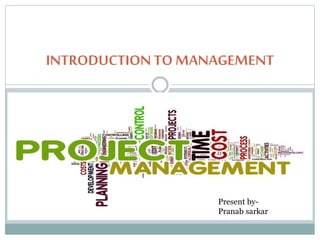
01.introduction of management
- 2. MANAGEMENT Management is the attainment of organizational goals in an effective and efficient manner through planning, organizing, staffing, directing and controlling organizational resources. Organizational resources include men(human beings), money, machines and materials.
- 3. Definitions Louis E Boone & David L Kurtz- The use of people and other resources to accomplish objectives. Mary Parker Follet- the act of getting things done through people. Frederick Taylor defines Management as the art of knowing what you want to do in the best and cheapest way.
- 4. INTRODUCTION TO MANAGEMENT Management is the process which is run by the expert and experience people whose works is to planning, organizing, directing, staffing, coordinating and budgeting (PODSCORB).
- 5. FUNCTION OF MANAGEMENT I. Management helps to get rich result in economic. II. Management uses the skill and experience of people, to get the job to be done. III. Management is a planning IV. It is a combination of science as well as arts. V. Management is a profession. VI. Management is a good activity. VII. It is a system of authority. VIII.It involves in decision making.
- 6. Concept of management 1. Planning. 2. Organizing. 3. Durability. 4. Directing. 5. Staffing. 6. Leadership. 7. Motivation. 8. Controlling. 9. co-ordination. 10. Decision making.
- 7. • Planning is determining the objectives and formulating the methods to achieve them. It is more simply said than done. A job well planned is half done. During planning one needs to ask oneself the following: • What am I trying to accomplish i.e. what is my objective? • What resources do I have and do I need to accomplish the same? • What are the methods and means to achieve the objectives? • Is this the optimal path? PLANNING
- 8. • Purposes or missions, • Objectives-It is the ultimate goal towards which the activities of the organization are directed • Strategies-general program of action and deployment of resources • Policies-general statement or understanding which guide or channel thinking in decision making • Procedures-states a series of related steps or tasks to be performed in a sequential way • Rules-prescribes a course of action and explicitly states what is to be done • Programs-comprehensive plan that includes future use of different resources • Budgets-statement of expected results expressed in numerical terms Types of Planning
- 9. Take Time to Plan Planning can be Top to Down or Bottom to Top Involve and Communicate with all those Concerned Plans must be Flexible and Dynamic Evaluate and Revise Principles of Planning
- 10. 1. Determining the goals or objectives for the entire organization. 2. Making assumptions on various elements of the environment. 3. To decide the planning period. 4. Examine alternative courses of actions. 5. Evaluating the alternatives. 6. Real point of decision making 7. To make derivative plans. Steps in Planning
- 11. Programmed Non programmed. Mechanistic-It is one that is routine and repetitive in nature Analytical-It involves a problem with a larger number of decision variables Judgmental-It involves a problem with a limited number of decision variables, but the outcomes of decision alternatives are unknown Adaptive-It involves a problem with a large number of decision variables, where outcomes are not predictable Types of Managerial Decisions:
- 12. Determine what is to be done/ Division of Work: Assign Tasks: Departmentalization: Link Departments: Hierarchy Development: Decide how much Authority to Designate/ Authority, Responsibility and Delegation: Decide the Levels at which Decisions are to be made / Centralization vs. Decentralization: Decide how to Achieve Coordination: Process of Organizing
- 13. Coordination by Rules or Procedures Coordination by Targets or Goals: Coordination through the Hierarchy Coordination through Departmentalization Using a Staff Assistant for Coordination: Using a Liaison for Coordination: Using a Committee for Coordination Using Independent Integrators for Coordination: Coordination through Mutual Adjustment: Techniques for achieving coordination.
- 14. Definition 1 Selecting and training individuals for specific job functions, and charging them with the associated responsibilities. Definition 2 Number of employed personnel in an organization or program. Also called workforce. STAFFING
- 15. Provides positive and dynamic leadership Provides maximum opportunities Provides proper motivation of personnel Ability to command people DIRECTING/LEADING
- 16. Feed Forward Control-Control that attempts to identify and prevent deviations before they occur is called feed forward control, sometimes called preliminary or preventive control. Concurrent Control-Control that monitors ongoing employee activities during their progress, to ensure they are consistent with quality standards, is called concurrent control. Feedback Control-In this case, the control takes place after the action. Sometimes called post-action or output control CONTROLLING CONCEPTS
- 17. Establish Standards of Performance Measure Actual Performance Compare Performance to Standards: Take Corrective Action Steps in the Control Process
- 18. LEVEL OF MANAGEMENT Top management Middle management Line management
- 19. Functions of top management 1. They sets their goal or objectives. 2. They organize the work. 3. They search for their required resources. 4. They control the management. 5. They have their strategic planning.
- 20. FUNCTIONS OF MIDDLE MANAGEMENT 1. They try to keep top management free as much as possible. 2. They try to keep the operation in smooth way. 3. They sets the departmental major policies. 4. They looks after the staff performance. 5. They looks after the staff training.
- 21. Functions of line management 1. They guides the workers. 2. They give training to the workers. 3. They take care of staff grievances. 4. If the worker are facing any problem then line management should inform to the middle management then to the top management. 5. They make necessary making environment.
